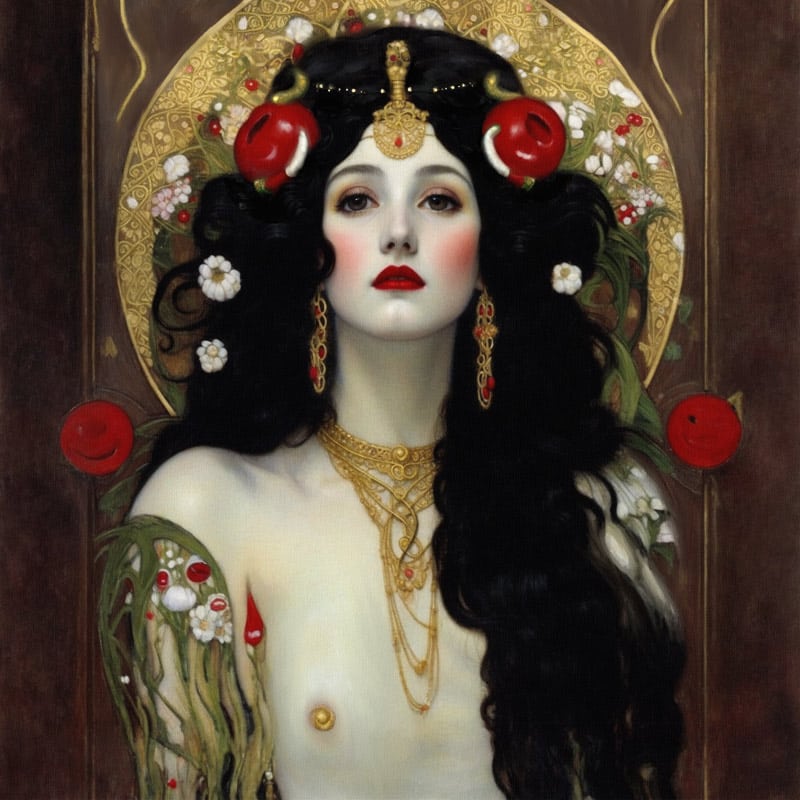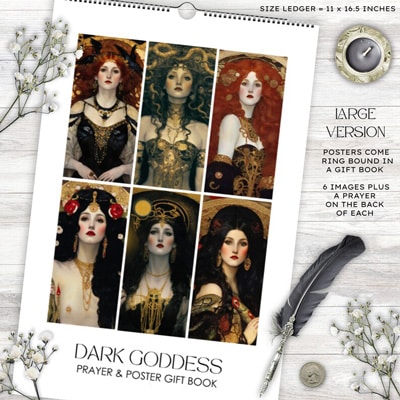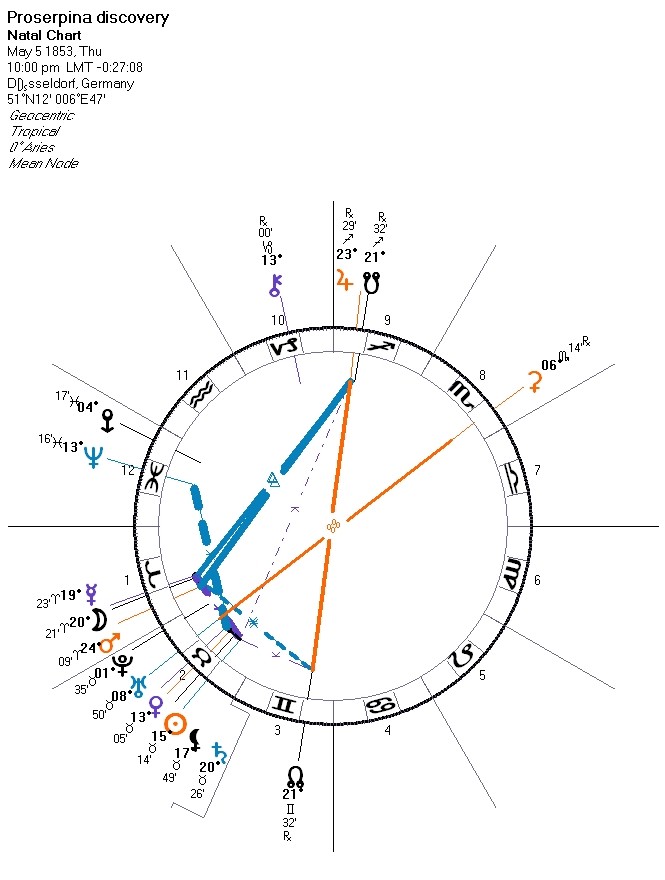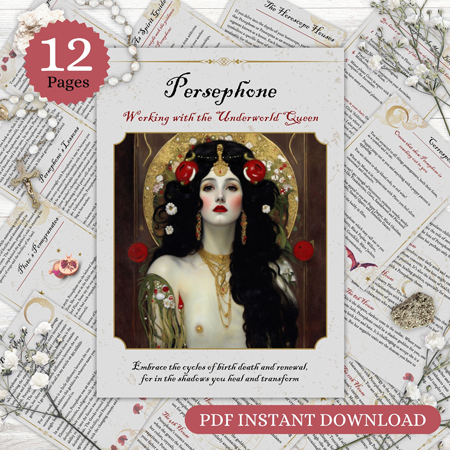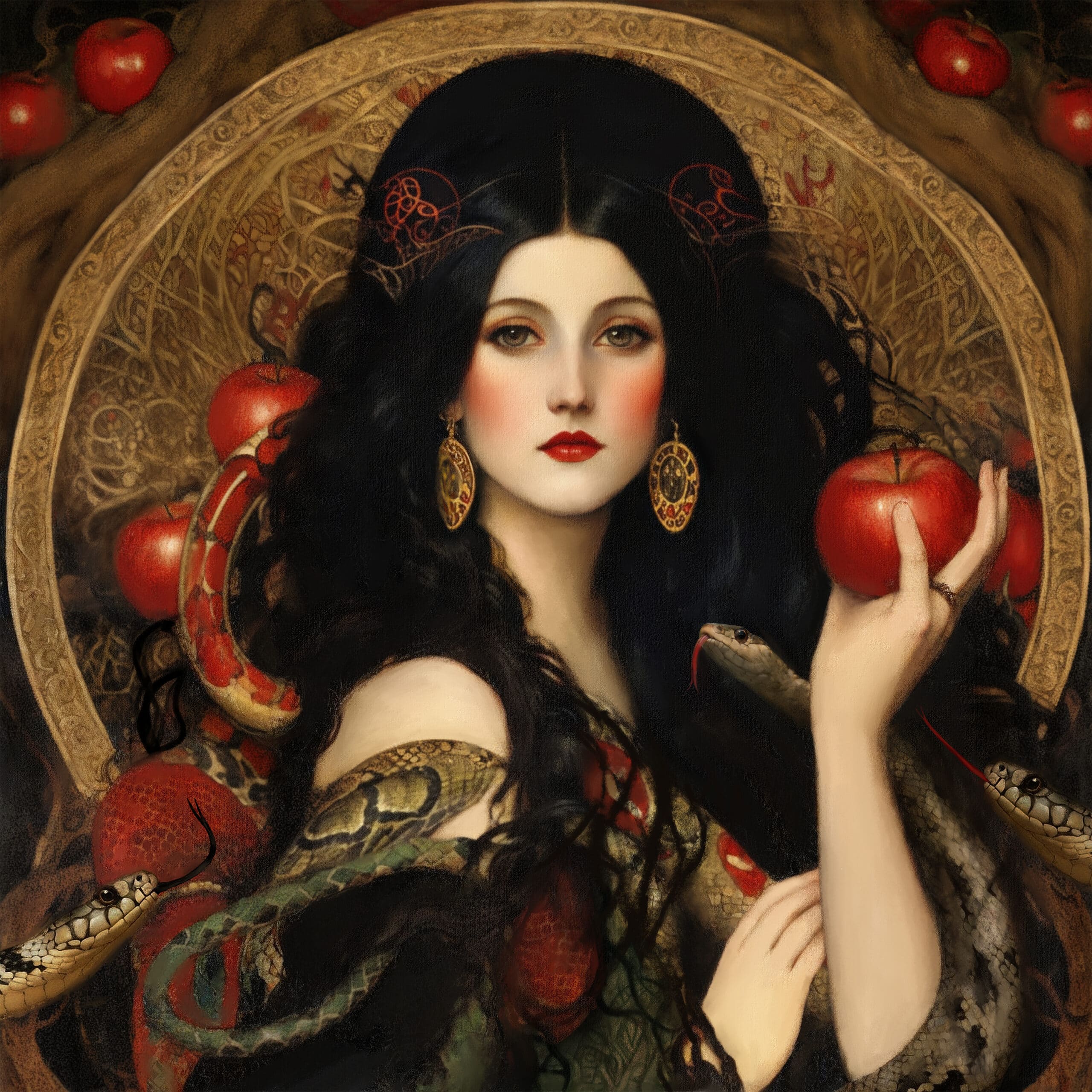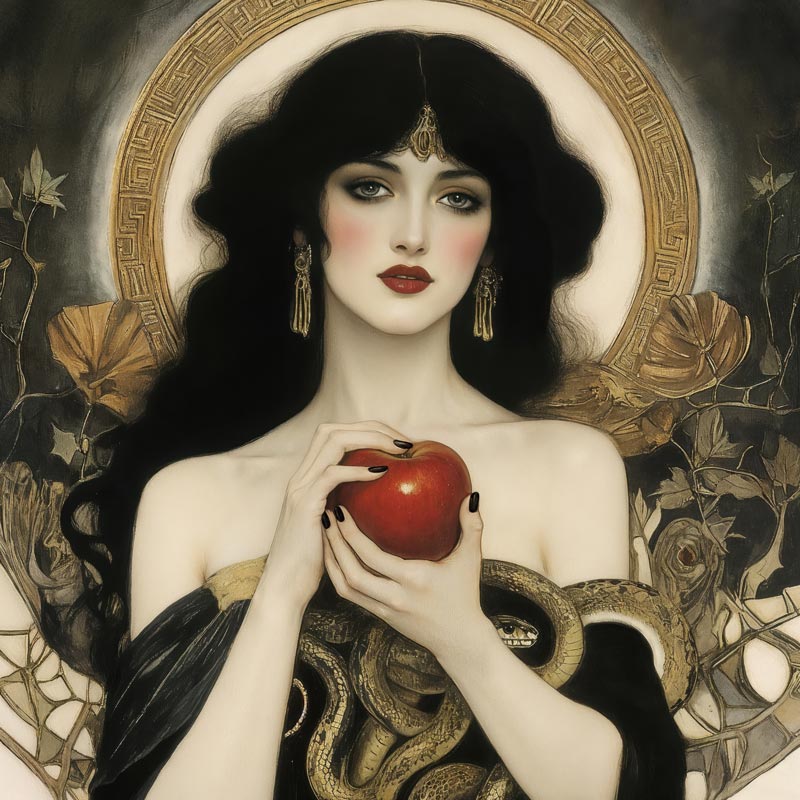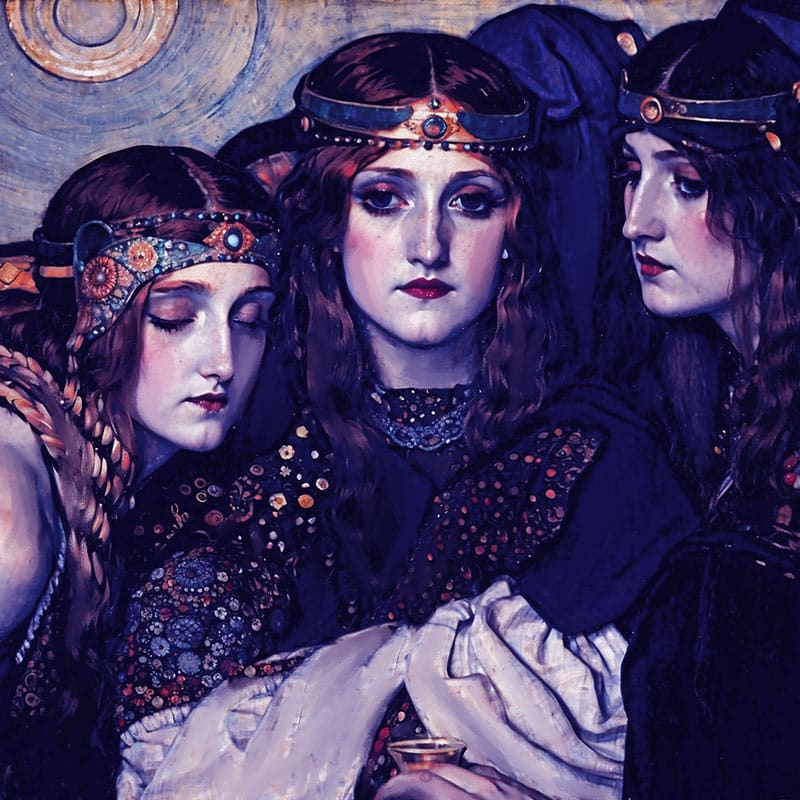The Persephone myth stands out as an enduring rite-of-passage tale involving the seasonal cycle. The dramatic story intertwines love, pain and death towards an awakening and eventual cosmic rebirth. Persephone is the Greek version while Proserpina is the Roman. While the core narrative of the myths behind them remains similar, there are some subtle differences between the two goddesses that become more apparent when we look deeper into the astrology behind the asteroids.
Members Only *
Goddesses Persphone & Proserpina
There are two listed asteroids for the queen of the underworld. The first is Roman Proserpina (Asteroid 26) discovered in 1853 followed by Greek Persephone (Asteroid 399) discovered in 1895. Because these names were already taken, Eris could not be named Persephone when she was discovered in 2005, despite the name being the favorite.
In ancient Greece, Persephone was an integral figure in the Eleusinian Mysteries, a religious cult in which initiates developed their connection to the spirit realm. The resulting ability to see into the future was considered a powerful and desirable trait. The Greeks revered Demeter as the goddess of agriculture and fertility, and Persephone, her daughter, became associated with the changing seasons and the cycle of life, death, and rebirth.
The Roman adaptation, while maintaining cyclicality, introduced elements of fertility and abundance tied to Proserpina’s return. The Romans, pragmatic and focused on earthly matters, emphasized the goddess’s role in ensuring the prosperity of crops and the fertility of the land.
Now, let’s explore both the Greek and Roman versions of the Persephone Myth to identify any differences. Persephone, also known as Kore in modern English, is the daughter of Zeus and Demeter and is considered the vegetation goddess. In Greek art, she is often portrayed carrying a sheaf of grain, resembling the Virgin in the constellation Virgo. This symbolism easily becomes part of Ceres’s attributes.
The greek myth
In the Greek myth, Persephone is abducted by Hades while picking flowers, and a great chasm opens up in the ground, pulling her into the Underworld. Demeter holds the earth for ransom, mourning her kidnapped daughter and causing a great drought. Zeus relents, allowing Persephone to spend half the year with her mother.
The story takes an intriguing turn as Demeter later bears another child (by another god) named Ploutos – the Roman version of Pluto. Ploutos, meaning wealth, represents the wealth of the corn stored underground. Ploutos is fused with Hades, symbolizing the dead, manure, and fertilizer holding the seeds of Kore. Kore merges with Persephone, the Queen of the Underworld, ascending through the earth as the new plant to reunite with her mother Demeter.
This complex family dynamic involves inter-breeding and interchangeability, emphasizing the cyclical nature of life and the interconnectedness of everything. It depicts the rite of passage from innocence/virginity to womanhood/wisdom and presents another version of the triple moon goddess: Persephone as the Maiden, Ceres as the Mother and Eris as the Matriarch/Witch.
The Roman Myth
Proserpina’s name is derived from the Latin “Serpere,” meaning “to crawl forward.” She is also associated with the serpent, depicted on Italian witch’s charms by a half moon entwined with a coiled serpent. Proserpina is the offspring of Ceres and Jupiter. The narrative unfolds with Venus directing her son Cupid to strike Pluto with one of his love arrows. Once again, Proserpina is engaged in flower picking, this time specifically in Sicily. Pluto emerges from the Etna Volcano on four black horses, forcefully takes her, and declares her as his Queen.
In this version, Pluto is her uncle. Ceres reacts by halting the growth of all fruits and cursing Sicily. Similar to the Greek myth, Pluto compels Proserpina to consume six pomegranate seeds, signifying the six months she must spend with him. Some variations suggest she willingly takes the seeds, perhaps indicating her desire for a dual life.
The Roman artwork seems to accentuate the “rape” element more. Modern feminists who reevaluate this myth propose that the alleged rape did not occur and that Proserpina willingly descended into the underworld to aid the dying. This interpretation of “rape” could have served as a strategy empowering maidens. In Sicily, eloping with a sweetheart was a means of escaping an overbearing family. Spending the night with a man led to marriage, as it was assumed the woman had been “raped” or had engaged in taboo acts, preserving her honor. Of course, the lady, portrayed as sweet and innocent, had no involvement in this scheme… 😉
Both versions are essentially similar, depicting the cycle of life, death, and rebirth. Persephone stands out as one of the few female examples of a resurrection deity, contrasting with predominantly male examples like Jesus, Krishna, Dionysus, Osiris, Orpheus, and Odin. The only other female example is Inanna or Ishtar, leading to the original Sumerian version of the Persephone myth, Innana & Ereshkigal.
For now, let’s focus on the distinctions between the Greek and Roman versions of Persephone by examining both discovery charts. I recommend exploring the relationship between planets Ceres, Eris, Pluto, and the personal planets in your chart to understand how the Persephone archetype operates. While asteroids are valuable for fine-tuning, consider them seriously only if they closely align with an angle, sun, moon, or ruling planet. This approach allows you to observe how these mythical themes influence your life.
Persephone Discovery Chart
This chart displays a shield aspect pattern intersected by mum Ceres. The shield involves Mars, Venus, Jupiter, and the Moon, symbolizing a tendency to keep others at a distance, sometimes using her mother as a buffer. Persephone tends to accuse and blame others, while her Mars/Venus sextile signifies her apparent pure beauty and unspoiled sexuality, akin to her maidenhead.
Persephone utilizes her beauty and perfection as a mask and protection. Notably, Ceres (Kore herself) is the apex of both Jupiter and Mars, describing her fertility and abundance. Persephone’s thinking tends towards obsession and paranoia, with Mercury square Pluto indicating difficulty in trusting and surrendering. This hints at a certain frigidity, manifesting as a girl unwilling to acknowledge sexual thoughts or own her sexuality, choosing instead to blame the man and portray herself as sweet and innocent.
The stars on Ceres further accentuate Persephone’s passionate, blindly good-hearted nature, hinting at unseen dangers and enmity. The Moon’s square to Uranus depicts nervousness and volatile emotions, with Persephone feeling smothered by her mother yet struggling with true independence. The Sun conjunct Mercury suggests a potential split personality, with the wise Queen of the Underworld concealed beneath apparent innocence. Interestingly, Roman Proserpina in this chart is closely conjunct with Pluto, revealing vulnerability when her guard is down.
Proserpina Discovery Chart
This chart exudes a more cohesive impression than Persephone’s, featuring a stronger blue presence and an absence of squares. The primary aspect pattern is the megaphone, indicative of a dynamic, lightning-fast personality capable of extracting diverse information and captivating an audience.
Proserpina is creative, artistic, and focused on her goal of becoming the Underworld Queen. Her Sun conjunct Venus adds charisma and a romantic nature, while the Sun sextile Neptune enhances her enchanting, dreamy qualities.
Venus on Menkar, the Sea monster, suggests potential dangers such as strong passions, jealousy, and domestic disharmony. Her Moon conjunct Mercury complements the megaphone aspect, making her an imaginative conversationalist with charm and wit. Although occasionally moody, Proserpina is less suspicious than her Greek sister.
The chart depicts the actual “rape” symbolically, with Jupiter on Aculeus, the stinger of the Scorpion, providing a vivid description of Pluto’s manhood. Mars, the planet of sex, on Al Pherg in Pisces signifies courageous and determined qualities. Ceres opposing Uranus suggests rebellion against her mother, and Pluto opposing Asteroid Proserpina reveals a confrontational nature compared to the more reserved Greek Persephone.
Asteroids Summary
Asteroid Persephone represents the innocent maiden before losing her virginity, while Asteroid Proserpina depicts the Goddess as a fully-fledged woman. This aligns with the Lilith story, where Persephone is Eve before biting the apple, and Proserpina is Eve afterward. The serpent symbolism associated with Proserpina could signify the release of Kundalini, bringing about sexual enlightenment and Lilith’s wisdom. Astrologically, the Roman Goddess appears as an upgraded version of the Greek one. Both versions, shaped by their times and environments, emphasize the rites of passage, psychic development, and the cyclical nature of life. The Greek version leans towards innocence and womanhood, linked to the Elusian mysteries, while the Roman adaptation portrays a more streetwise and sophisticated perspective, emphasizing agricultural aspects and the impact of scarcity on personal growth.
The Rest Of This Article Available As Printable Pdf Grimoire On Etsy Or Free For Members
How to Find Persephone & Proserpina in your chart
1. Create your chart HERE.
2. Click “additional objects”
3. Add in the numbers 26 for Proserpina and 399 for Persephone followed by a comma in the manual entry box.

